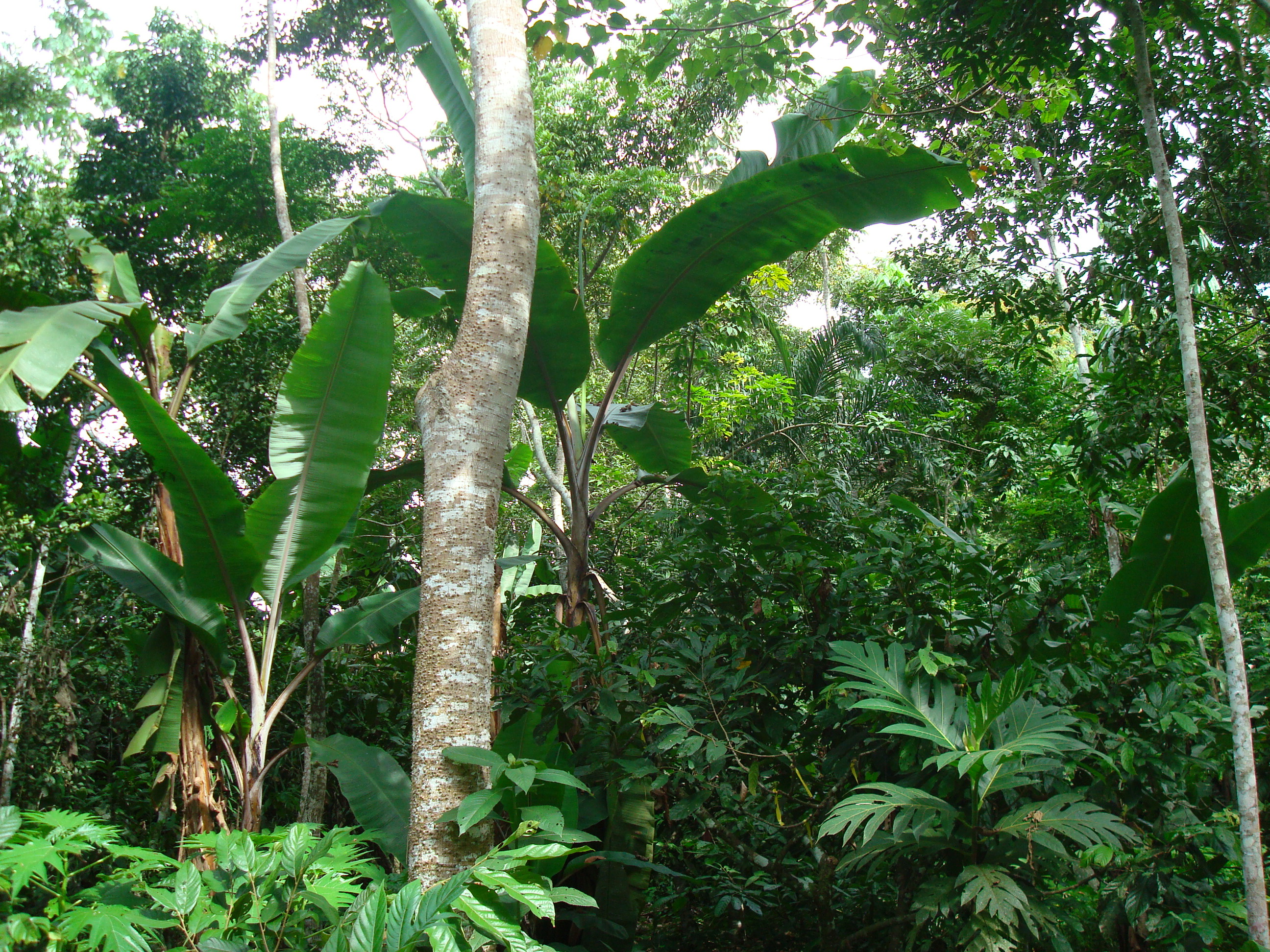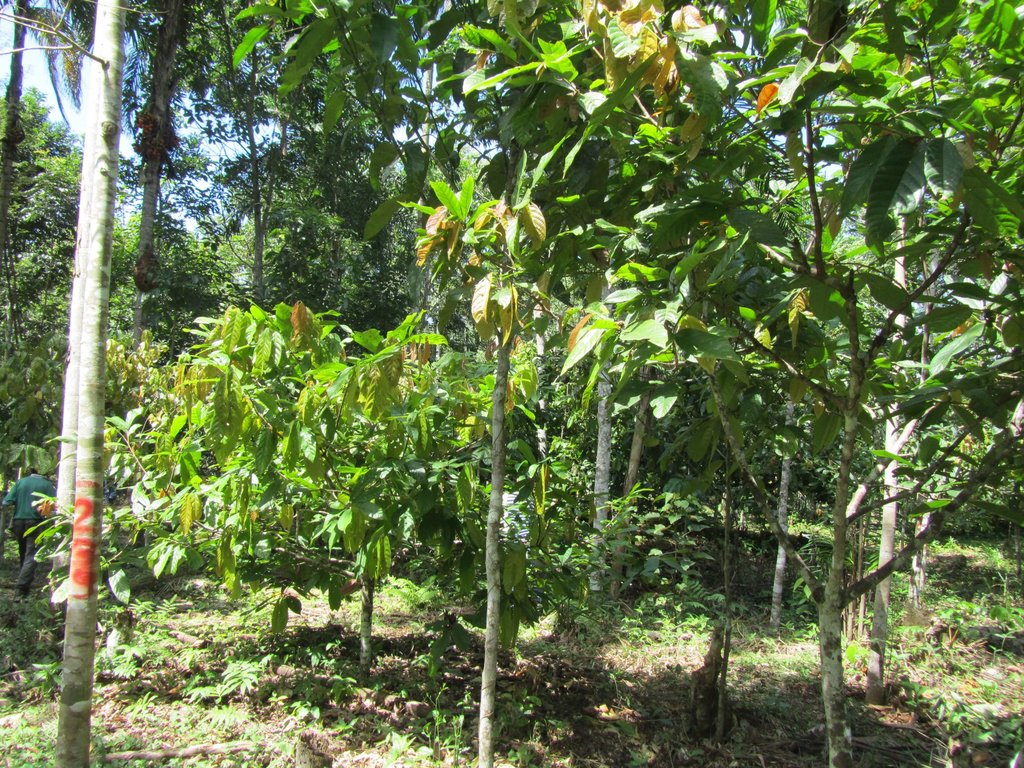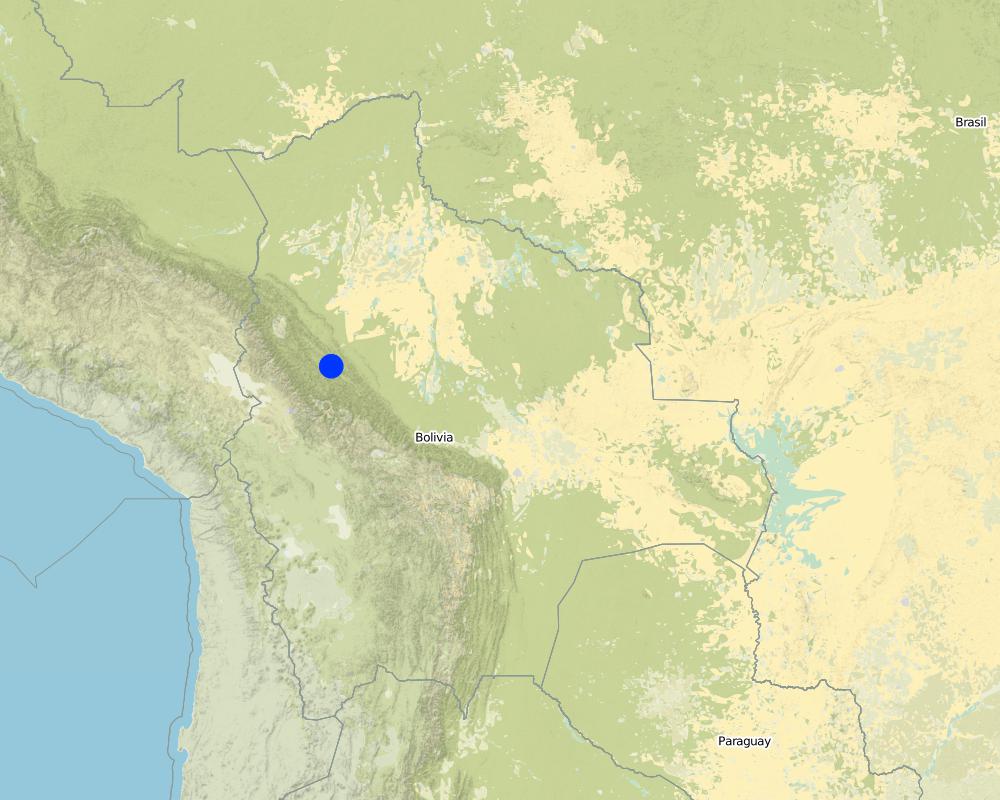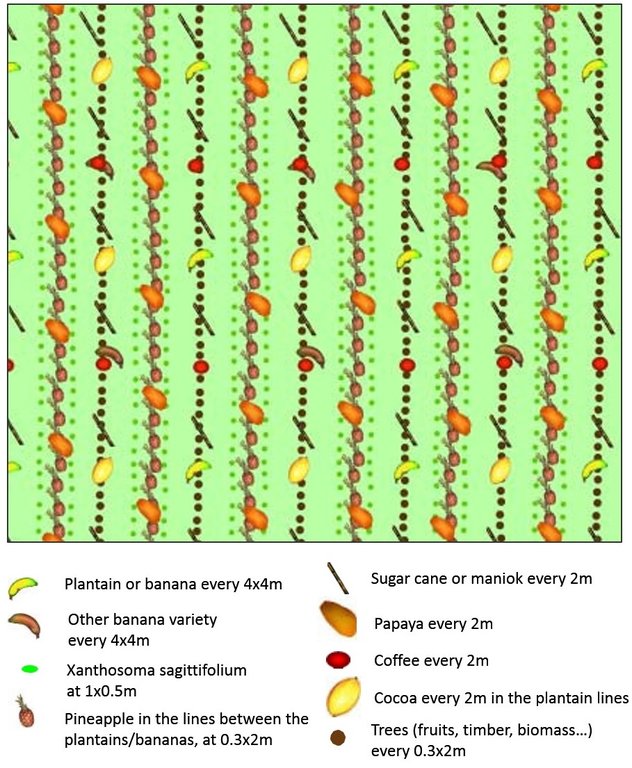Dynamic agroforestry systems [โบลิเวีย]
- ผู้สร้างสรรค์:
- การอัพเดท:
- ผู้รวบรวม: Johanna Jacobi
- ผู้เรียบเรียง: –
- ผู้ตรวจสอบ: Alexandra Gavilano
Sistemas agroforestales dinámicos o sucesionales (Safs)
technologies_513 - โบลิเวีย
ดูส่วนย่อย
ขยายทั้งหมด ย่อทั้งหมด1. ข้อมูลทั่วไป
1.2 รายละเอียดที่ติดต่อได้ของผู้รวบรวมและองค์กรที่เกี่ยวข้องในการประเมินและการจัดเตรียมทำเอกสารของเทคโนโลยี
1.3 เงื่อนไขการใช้ข้อมูลที่ได้บันทึกผ่านทาง WOCAT
ผู้รวบรวมและวิทยากรหลักยอมรับเงื่อนไขเกี่ยวกับการใช้ข้อมูลที่ถูกบันทึกผ่านทาง WOCAT:
ใช่
1.4 การเปิดเผยเรื่องความยั่งยืนของเทคโนโลยีที่ได้อธิบายไว้
เทคโนโลยีที่ได้อธิบายไว้นี้เป็นปัญหาของความเสื่อมโทรมโทรมของที่ดินหรือไม่ จึงไม่ได้รับการยอมรับว่าเป็นเทคโนโลยีเพื่อการจัดการที่ดินอย่างยั่งยืน:
ไม่ใช่
2. การอธิบายลักษณะของเทคโนโลยี SLM
2.1 การอธิบายแบบสั้น ๆ ของเทคโนโลยี
คำจำกัดความของเทคโนโลยี:
Dynamic agroforestry systems are highly diversified farming systems which go through the different phases of the natural succession, from pioneer plant dominated stages up to primary trees dominated stages, were the different strata are used for different crops, and where pruning and selective weeding enhances the dynamic development of plant synergies.
2.2 การอธิบายแบบละเอียดของเทคโนโลยี
คำอธิบาย:
The approach is different from simple agroforestry because it makes use of the different strata and stages of natural succession which it mimicks with crops and native plants that accumulate biomass and create shade and enabling conditions while crops are small. Main activities are pruning and selective weeding. Managing such a system requires a profound knowledge of locally adapted crops and the local vegeation, and also of plant growth dynamics. There is no general recipe as a dynamic agroforestry system looks different in each place, but there are universal agroecological principles such as the natural succession stages and biodiversity. Dynamic agroforestry is like other agroforestry systems useful to implement an efficient land-use system which does not necessarily degrade soils, water sources and biodiversity, while producing different goods (food, feed, construction material, medicines....) at different times of the year. Dynamic agroforestry have the specialty that the pioneer plants produce already in the first year (e.g. rice or corn), so that a hunger gap can be avoided until the main crop (e.g. cocoa) starts producing after several years. There is a long history of capacity building, field trials and farmers own experiments in different ecoregions of Bolivia. Farmer-to-farmer trainings have been used as well as NGO-led projects to install plots on farmers' lands. In Bolivia, different groups of farmers and NGOs started to use dynamic agroforestry after courses by Ernst Götsch from Brazil in Alto Beni in Bolivia with cocoa agroforestry systems in the 1990s. From there the knowledge spread constantly through different people experimenting, mainla in the sub-humid lowlands of the Amazon Basin, but also in semi-arid regions around Cochabamba. Today there are many exchanging events with interested farmers and experts fom other countries, and a larger dynamic agroforestry project in Cote D'Ivoire. There is also an annual international one-week course on dynamic agroforestry taking place in Bolivia led by the NGO Ecotop. NGO founders from different parts of the world who have long been living in Bolivia and manage agroforestry farms themselves have been playing an important role in advancing the approach by organizing courses and events, some scientists have conducted research on soil fertility, yields, pests and diseases, and many farmers have long-standing experience from experiments with dynamic agroforestry on their land.
2.3 รูปภาพของเทคโนโลยี
2.5 ประเทศภูมิภาค หรือสถานที่ตั้งที่เทคโนโลยีได้นำไปใช้และได้รับการครอบคลุมโดยการประเมินนี้
ประเทศ:
โบลิเวีย
ภูมิภาค/รัฐ/จังหวัด:
Alto Beni/La Paz
ระบุการกระจายตัวของเทคโนโลยี:
- ใช้ ณ จุดที่เฉพาะเจาะจงหรือเน้นไปยังบริเวณพื้นที่ขนาดเล็ก
แสดงความคิดเห็น:
Implemented by "lighthouse" farmers, and participants of projects
Map
×2.6 วันที่การดำเนินการ
ถ้าไม่รู้ปีที่แน่นอน ให้ระบุวันที่โดยประมาณ:
- 10-50 ปี
2.7 คำแนะนำของเทคโนโลยี
ให้ระบุว่าเทคโนโลยีถูกแนะนำเข้ามาอย่างไร:
- ในช่วงการทดลองหรือการทำวิจัย
- ทางโครงการหรือจากภายนอก
ความคิดเห็น (ประเภทของโครงการ เป็นต้น) :
Exchange with agroforestry farmers from other places (e.g. Ernst Götsch, Bahia Brazil)
3. การจัดประเภทของเทคโนโลยี SLM
3.1 วัตถุประสงค์หลักของเทคโนโลยี
- ปรับปรุงการผลิตให้ดีขึ้น
- ลด ป้องกัน ฟื้นฟู การเสื่อมโทรมของที่ดิน
- อนุรักษ์ระบบนิเวศน์
- ป้องกันพื้นที่ลุ่มน้ำ/บริเวณท้ายน้ำ โดยร่วมกับเทคโนโลยีอื่นๆ
- รักษาสภาพหรือปรับปรุงความหลากหลายทางชีวภาพ
- ปรับตัวเข้ากับการเปลี่ยนแปลงภูมิอากาศของโลก สภาพภูมิอากาศที่รุนแรงและผลกระทบ
- ชะลอการเปลี่ยนแปลงภูมิอากาศของโลกและผลกระทบ
3.2 ประเภทของการใช้ที่ดินในปัจจุบันที่ได้นำเทคโนโลยีไปใช้

พื้นที่ปลูกพืช
- การปลูกพืชล้มลุกอายุปีเดียว
- การปลูกพืชยืนต้นที่ไม่มีเนื้อไม้
- การปลูกไม้ยืนต้น ไม้พุ่ม
- rice, corn
Tree and shrub cropping - Specify crops:
- cacao
- citrus
- papaya
- banana
จำนวนของฤดูเพาะปลูกต่อปี:
- 1
ระบุ:
Annual crops are grown in the rainy season

ป่า/พื้นที่ทำไม้
ผลิตภัณฑ์และบริการ:
- ไม้ซุง
- ไม้ที่นำมาทำเป็นเชื้อเพลิง
- ผลไม้และถั่ว
- ผลิตภัณฑ์อื่น ๆ จากป่า
- การป้องกันภัยธรรมชาติ
3.4 การใช้น้ำ
การใช้น้ำของที่ดินที่มีการใช้เทคโนโลยีอยู่:
- จากน้ำฝน
แสดงความคิดเห็น:
Great vulnerbaility of cash and food crops to drought (e.g. cocoa trees)
3.5 กลุ่ม SLM ที่ตรงกับเทคโนโลยีนี้
- การปลูกป่าร่วมกับพืช
3.6 มาตรการ SLM ที่ประกอบกันเป็นเทคโนโลยี

มาตรการอนุรักษ์ด้วยวิธีพืช
- V1: ต้นไม้และพุ่มไม้คลุมดิน

มาตรการอนุรักษ์ด้วยการจัดการ
- M1: การเปลี่ยนรูปแบบของการใช้ประโยชน์ที่ดิน
- M2: การเปลี่ยนแปลงของการจัดการหรือระดับความเข้มข้น
- M3: การวางผังตามสิ่งแวดล้อมทางธรรมชาติและสิ่งแวดล้อมของมนุษย์
- M4: การเปลี่ยนแปลงช่วงเวลาให้เหมาะแก่การทำกิจกรรม
- M5: การควบคุมหรือการเปลี่ยนแปลงขององค์ประกอบของชนิดพันธุ์
3.7 รูปแบบหลักของการเสื่อมโทรมของที่ดินที่ได้รับการแก้ไขโดยเทคโนโลยี

การกัดกร่อนของดินโดยน้ำ
- Wt (Loss of topsoil): การสูญเสียดินชั้นบนหรือการกัดกร่อนที่ผิวดิน
- Wm (Mass movement): การเคลื่อนตัวของมวลดินหรือดินถล่ม

การกัดกร่อนของดินโดยลม
- Et (Loss of topsoil): การสูญเสียดินชั้นบน

การเสื่อมโทรมของดินทางด้านเคมี
- Cn (Fertility decline): ความอุดมสมบูรณ์และปริมาณอินทรียวัตถุในดินถูกทำให้ลดลงไป (ไม่ได้เกิดจากสาเหตุการกัดกร่อน)
- Ca (Acidification): การเกิดกรด

การเสื่อมโทรมของดินทางด้านกายภาพ
- Pc (Compaction): การอัดแน่น

การเสื่อมโทรมของดินทางด้านชีวภาพ
- Bc (Reduction of vegetation cover): การลดลงของจำนวนพืชที่ปกคลุมดิน
- Bh (Loss of habitat): การสูญเสียแหล่งที่อยู่
- Bq (Quantity/biomass decline): การลดลงของปริมาณหรือมวลชีวภาพ
- Bf (Detrimenta leffects of fires): ผลเสียหายจากไฟ
- Bs (Quality and species composition): องค์ประกอบหรือความหลากหลายทางคุณภาพและชนิดพันธุ์ลดลง
- Bl (Loss of soil life): การสูญเสียสิ่งมีชีวิตในดิน
- Bp (Increase of pests/diseases): การเพิ่มขึ้นของศัตรูพืชและโรคพืช

การเสื่อมโทรมของน้ำ
- Ha (Aridification): การเกิดความแห้งแล้ง
- Hs (Change in quantity of surface water): การเปลี่ยนแปลงปริมาณของน้ำที่ผิวดิน
3.8 การป้องกัน การลดลง หรือการฟื้นฟูความเสื่อมโทรมของที่ดิน
ระบุเป้าหมายของเทคโนโลยีกับความเสื่อมโทรมของที่ดิน:
- ป้องกันความเสื่อมโทรมของที่ดิน
- ฟื้นฟูบำบัดที่ดินที่เสื่อมโทรมลงอย่างมาก
4. ข้อมูลจำเพาะด้านเทคนิค กิจกรรมการนำไปปฏิบัติใช้ ปัจจัยนำเข้า และค่าใช้จ่าย
4.1 แบบแปลนทางเทคนิคของเทคโนโลยี
ข้อมูลจำเพาะด้านเทคนิค (แบบแปลนทางเทคนิคของเทคโนโลยี):
For reasons of visibility, the vertical drawing only contains crops and not plants that are planted in between for biomass accumulation . The recommendations to install the plot are as follows:
plantain or banana every 4 m; another banana variety (mainly red banana) every 4m in alternating rows so that banana/plantain rows result with 2m distance; Pineapple between the banana and plantain rows every 0.3 m with 2m distance between the rows; hualuza (Xanthosoma sagittifolium) every 0.5m left and right to the rows with pineapple; sugar cane or maniok every 2m in the plantain/banan rows; papaya every 2m in the plantain/banana rows; fruit trees, timber trees and biomass-accumulating trees every 0.3m in the banana/plantain rows with a distance of 2m between rows; café every 2m in the banana/plantain rows; cocoa every 4m in the banana/plantain rows. Rice, Cajanus cajan, corn and hibiscus should be sown everywhere in between.
ผู้เขียน:
Yana and Weinert 2001, altered
วันที่:
2001
4.2 ข้อมูลทั่วไปเกี่ยวกับการคำนวณปัจจัยนำเข้าและค่าใช้จ่าย
ให้ระบุว่าค่าใช้จ่ายและปัจจัยนำเข้าได้รับการคำนวณอย่างไร:
- ต่อพื้นที่ที่ใช้เทคโนโลยี
ระบุขนาดและหน่วยพื้นที่:
1 hectare
อื่นๆ หรือสกุลเงินประจำชาติ (ระบุ):
BOB
ระบุค่าเฉลี่ยของค่าจ้างในการจ้างแรงงานต่อวัน:
100 BOB
4.3 กิจกรรมเพื่อการจัดตั้ง
| กิจกรรม | Timing (season) | |
|---|---|---|
| 1. | Plot establishment withour burning | When the rains start |
| 2. | selective weeding | Every 3 months |
| 3. | Pruning | Before the rains start |
| 4. | Harvesting | Constant |
4.4 ค่าใช้จ่ายของปัจจัยนำเข้าที่จำเป็นสำหรับการจัดตั้ง
แสดงความคิดเห็น:
Implementing a dynamic agorofrestry plot with cocoa costs 3500-3600 BOB/ha, as compared to a cocoa monoculture with around 1400 BOB/ha. However, this expenditure is recovered during the first year through annual crops such as rice, causing a net gain in dynamic agroforestry plots of around 3000 BOB/ha whereas cocoa monocultures have a let loss of around 300 BOB in the first year (since there are no annual crops to sell).
4.5 การบำรุงรักษาสภาพหรือกิจกรรมที่เกิดขึ้นเป็นประจำ
| กิจกรรม | ช่วงระยะเวลา/ความถี่ | |
|---|---|---|
| 1. | Selective weeding | Every three months |
| 2. | Pruning | Before rains start |
| 3. | Harvesting | Continuous |
| 4. | Replanting | During rainy season |
4.6 ค่าใช้จ่ายของปัจจัยนำเข้าและกิจกรรมที่เกิดขึ้นเป็นประจำที่ต้องการการบำรุงรักษา (ต่อปี)
If you are unable to break down the costs in the table above, give an estimation of the total costs of maintaining the Technology:
1000.0
4.7 ปัจจัยสำคัญที่สุดที่มีผลกระทบต่อค่าใช้จ่าย
ปัจจัยสำคัญที่สุดที่มีผลกระทบต่อค่าใช้จ่ายต่างๆ:
Available labor
5. สิ่งแวดล้อมทางธรรมชาติและของมนุษย์
5.1 ภูมิอากาศ
ฝนประจำปี
- < 250 ม.ม.
- 251-500 ม.ม.
- 501-750 ม.ม.
- 751-1,000 ม.ม.
- 1,001-1,500 ม.ม.
- 1,501-2,000 ม.ม.
- 2,001-3,000 ม.ม.
- 3,001-4,000 ม.ม.
- > 4,000 ม.ม.
ระบุปริมาณน้ำฝนเฉลี่ยรายปี (ถ้ารู้) :หน่วย ม.ม.
1500.00
ข้อมูลจำเพาะ/ความคิดเห็นเรื่องปริมาณน้ำฝน:
Mainly in rainy season from November to March
ระบุชื่อของสถานีตรวดวัดอากาศที่ใช้อ้างอิงคือ:
Estación experimental El Ceibo Sapecho
เขตภูมิอากาศเกษตร
- กึ่งชุ่มชื้น
5.2 สภาพภูมิประเทศ
ค่าเฉลี่ยความลาดชัน:
- ราบเรียบ (0-2%)
- ลาดที่ไม่ชัน (3-5%)
- ปานกลาง (6-10%)
- เป็นลูกคลื่น (11-15%)
- เป็นเนิน (16-30%)
- ชัน (31-60%)
- ชันมาก (>60%)
ธรณีสัณฐาน:
- ที่ราบสูง/ที่ราบ
- สันเขา
- ไหล่เขา
- ไหล่เนินเขา
- ตีนเนิน
- หุบเขา
ระดับความสูง:
- 0-100 เมตร
- 101-500 เมตร
- 501-1,000 เมตร
- 1,001-1,500 เมตร
- 1,501-2,000 เมตร
- 2,001-2,500 เมตร
- 2,501-3,000 เมตร
- 3,001-4,000 เมตร
- > 4,000 เมตร
ให้ระบุถ้าเทคโนโลยีได้ถูกนำไปใช้:
- บริเวณสันเขา (convex situations)
5.3 ดิน
ค่าเฉลี่ยความลึกของดิน:
- ตื้นมาก (0-20 ซ.ม.)
- ตื้น (21-50 ซ.ม.)
- ลึกปานกลาง (51-80 ซ.ม.)
- ลึก (81-120 ซ.ม.)
- ลึกมาก (>120 ซ.ม.)
เนื้อดิน (ดินชั้นบน):
- หยาบ/เบา (ดินทราย)
- ปานกลาง (ดินร่วน ทรายแป้ง)
เนื้อดินล่าง (> 20 ซ.ม.ต่ำจากผิวดิน):
- หยาบ/เบา (ดินทราย)
อินทรียวัตถุในดิน:
- ปานกลาง (1-3%)
(ถ้ามี) ให้แนบคำอธิบายเรื่องดินแบบเต็มหรือระบุข้อมูลที่มีอยู่ เช่น ชนิดของดิน ค่า pH ของดินหรือความเป็นกรดของดิน ความสามารถในการแลกเปลี่ยนประจุบวก ไนโตรเจน ความเค็ม เป็นต้น:
Ph: 6-7.8, P: 15-17.8 mg/kg, N: 0.12-0.18%, SOM: 1.2-1.8%, K: 0.12-0.8 cmolc/kg, CEC: 8.2-15.4 cmolc/kg (all 0-25 cm depth)
5.4 ความเป็นประโยชน์และคุณภาพของน้ำ
ระดับน้ำใต้ดิน:
<5 เมตร
น้ำไหลบ่าที่ผิวดิน:
ดี
คุณภาพน้ำ (ที่ยังไม่ได้บำบัด):
เป็นน้ำเพื่อการดื่มที่ดี
ความเค็มของน้ำเป็นปัญหาหรือไม่:
ไม่ใช่
กำลังเกิดน้ำท่วมในพื้นที่หรือไม่:
ใช่
บ่อยครั้ง:
เป็นครั้งเป็นคราว
5.5 ความหลากหลายทางชีวภาพ
ความหลากหลายทางชนิดพันธุ์:
- สูง
ความหลากหลายของแหล่งที่อยู่:
- สูง
ความคิดเห็นและข้อมูลจำเพาะเพิ่มเติมของความหลากหลายทางชีวภาพ:
The Tropical Andes which the Yungas of La Paz form part of, are a "hot spot of biodiversity"
5.6 ลักษณะของผู้ใช้ที่ดินที่นำเทคโนโลยีไปปฏิบัติใช้
อยู่กับที่หรือเร่ร่อน:
- อยู่กับที่
แนวทางการตลาดของระบบการผลิต:
- mixed (subsistence/ commercial)
รายได้ที่มาจากนอกฟาร์ม:
- 10-50% ของรายได้ทั้งหมด
ระดับของความมั่งคั่งโดยเปรียบเทียบ:
- พอมีพอกิน
เป็นรายบุคคล/ครัวเรือน:
- เป็นรายบุคคล/ครัวเรือน
ระดับของการใช้เครื่องจักรกล:
- งานที่ใช้แรงกาย
เพศ:
- หญิง
- ชาย
อายุของผู้ใช้ที่ดิน:
- ผู้เยาว์
- วัยกลางคน
5.7 Average area of land used by land users applying the Technology
- < 0.5 เฮกตาร์
- 0.5-1 เฮกตาร์
- 1-2 เฮกตาร์
- 2-5 เฮกตาร์
- 5-15 เฮกตาร์
- 15-50 เฮกตาร์
- 50-100 เฮกตาร์
- 100-500 เฮกตาร์
- 500-1,000 เฮกตาร์
- 1,000-10,000 เฮกตาร์
- >10,000 เฮกตาร์
พิจารณาว่าเป็นขนาดเล็ก กลาง หรือขนาดใหญ่ (ซึ่งอ้างอิงถึงบริบทระดับท้องถิ่น):
- ขนาดเล็ก
แสดงความคิดเห็น:
Frequently, only 1-5 ha of the 12-15 ha that every family has is used for cropping
5.8 กรรมสิทธิ์ในที่ดิน สิทธิในการใช้ที่ดินและสิทธิในการใช้น้ำ
กรรมสิทธิ์ในที่ดิน:
- รายบุคคล ได้รับสิทธิครอบครอง
สิทธิในการใช้ที่ดิน:
- รายบุคคล
สิทธิในการใช้น้ำ:
- เกี่ยวกับชุมชน (ถูกจัดระเบียบ)
5.9 การเข้าถึงบริการและโครงสร้างพื้นฐาน
สุขภาพ:
- จน
- ปานกลาง
- ดี
การศึกษา:
- จน
- ปานกลาง
- ดี
ความช่วยเหลือทางด้านเทคนิค:
- จน
- ปานกลาง
- ดี
การจ้างงาน (เช่น ภายนอกฟาร์ม):
- จน
- ปานกลาง
- ดี
ตลาด:
- จน
- ปานกลาง
- ดี
พลังงาน:
- จน
- ปานกลาง
- ดี
ถนนและการขนส่ง:
- จน
- ปานกลาง
- ดี
น้ำดื่มและการสุขาภิบาล:
- จน
- ปานกลาง
- ดี
บริการด้านการเงิน:
- จน
- ปานกลาง
- ดี
6. ผลกระทบและสรุปคำบอกกล่าว
6.1 ผลกระทบในพื้นที่ดำเนินการ (On-site) จากการใช้เทคโนโลยี
ผลกระทบทางด้านเศรษฐกิจและสังคม
การผลิต
การผลิตพืชผล
จำนวนก่อน SLM:
350 kg/ha/y dry cocoa beans
หลังจาก SLM:
510 kg/ha/y dry cocoa beans
แสดงความคิดเห็น/ระบุ:
The implementation of the tecnology implied a better understanding of cocoa growing in general (e.g. in terms of pruning) which may have led to the higher yields under dynamic agroforestry
การผลิตไม้
จำนวนก่อน SLM:
0
หลังจาก SLM:
abundant
แสดงความคิดเห็น/ระบุ:
A mahogany tree can be grown every 12m in a dynamic agroforestry cocoa plot, but its development depends on many differnt factors.
การผลิตของจากป่าทุกชนิดยกเว้นไม้
แสดงความคิดเห็น/ระบุ:
The highly diversified plota provide many different NTFP
การเสี่ยงต่อความล้มเหลวในการผลิต
แสดงความคิดเห็น/ระบุ:
Vulnerability to food insecurity decreased greatly, economic risk decreases moderately as cocoa is still the most important cash crop and crop failure can also occur in dynamic agroforestry plots.
ความหลากหลายของผลิตภัณฑ์
จำนวนก่อน SLM:
1-3
หลังจาก SLM:
10-15
รายได้และค่าใช้จ่าย
รายได้จากฟาร์ม
จำนวนก่อน SLM:
6044 BOB/y/family
หลังจาก SLM:
7530 BOB/y/family
แสดงความคิดเห็น/ระบุ:
Connected to organic and Fair Trade certificacion which the monoculture farmers usually don't have
ความหลากหลายของแหล่งผลิตรายได้
จำนวนก่อน SLM:
3.5
หลังจาก SLM:
3.2
แสดงความคิดเห็น/ระบุ:
People invested more in cocoa farming than in off-farm income sources
ภาระงาน
แสดงความคิดเห็น/ระบุ:
2410 SAF vs 5000 Mono costo mano de obra
6.2 ผลกระทบนอกพื้นที่ดำเนินการ (Off-site) จากการใช้เทคโนโลยี
Specify assessment of off-site impacts (measurements):
no specific
6.3 การเผชิญและความตอบสนองของเทคโนโลยีต่อการเปลี่ยนแปลงสภาพภูมิอากาศที่ค่อยเป็นค่อยไป และสภาพรุนแรงของภูมิอากาศ / ภัยพิบัติ (ที่รับรู้ได้โดยผู้ใช้ที่ดิน)
สภาพรุนแรงของภูมิอากาศ (ภัยพิบัติ)
ภัยพิบัติจากสภาพภูมิอากาศ
| เทคโนโลยีมีวิธีการรับมืออย่างไร | |
|---|---|
| คลื่นความร้อน | ดีมาก |
| ภัยจากฝนแล้ง | ปานกลาง |
ภัยพิบัติทางชีวภาพ
| เทคโนโลยีมีวิธีการรับมืออย่างไร | |
|---|---|
| โรคระบาด | ปานกลาง |
แสดงความคิดเห็น:
A main benefit related to climate change aspects according to the land users is that they can work in the shade.
6.4 การวิเคราะห์ค่าใช้จ่ายและผลประโยชน์ที่ได้รับ
ผลประโยชน์ที่ได้รับเปรียบเทียบกับค่าใช้จ่ายในการจัดตั้งเป็นอย่างไร (จากมุมมองของผู้ใช้ที่ดิน)
ผลตอบแทนระยะสั้น:
ด้านลบเล็กน้อย
ผลตอบแทนระยะยาว:
ด้านบวก
ผลประโยชน์ที่ได้รับเปรียบเทียบกับค่าใช้จ่ายในการบำรุงรักษาหรือต้นทุนที่เกิดขึ้นซ้ำอีก เป็นอย่างไร (จากมุมมองของผู้ใช้ที่ดิน)
ผลตอบแทนระยะสั้น:
ด้านบวกอย่างมาก
ผลตอบแทนระยะยาว:
ด้านบวกเล็กน้อย
6.5 การปรับตัวของเทคโนโลยี
- 1-10%
Of all those who have adopted the Technology, how many did so spontaneously, i.e. without receiving any material incentives/ payments?
- 51-90%
แสดงความคิดเห็น:
Most have participated in a course and/or received some technical advice, but mostly without material incentives
6.6 การปรับตัว
เทคโนโลยีได้รับการปรับเปลี่ยนเมื่อเร็วๆนี้ เพื่อให้ปรับตัวเข้ากับสภาพที่กำลังเปลี่ยนแปลงหรือไม่:
ใช่
อื่น ๆ (ระบุ):
Lack of in-depth knowledge
ให้ระบุการปรับตัวของเทคโนโลยี (การออกแบบ วัสดุหรือชนิดพันธุ์ เป็นต้น):
Simplified versions have been tried out (with less density and iversity of plants)
6.7 จุดแข็ง / ข้อได้เปรียบ / โอกาสของเทคโนโลยี
| จุดแข็ง / ข้อได้เปรียบ / โอกาสในทัศนคติของผู้ใช้ที่ดิน |
|---|
| Ecologically adapted, favorable working conditions (shade, cooler than full-sun systems), diversity of products |
| จุดแข็ง / ข้อได้เปรียบ / โอกาสในทัศนคติของผู้รวบรวมหรือวิทยากรหลัก |
|---|
| Short-term (annual crops first year). mid-term (cocoa etc.) and long-term economic strategy when high-value timber trees are included (e.g. mahogany) |
6.8 จุดอ่อน / ข้อเสียเปรียบ / ความเสี่ยงของเทคโนโลยีและวิธีการแก้ไข
| จุดอ่อน / ข้อเสียเปรียบ / ความเสี่ยงในทัศนคติของผู้ใช้ที่ดิน | มีวิธีการแก้ไขได้อย่างไร |
|---|---|
| Sometimes, yields are low. Produce cannot always be sold at a good price | Technical support, develop market access |
| จุดอ่อน / ข้อเสียเปรียบ / ความเสี่ยงในทัศนคติของผู้รวบรวมหรือวิทยากรหลัก | มีวิธีการแก้ไขได้อย่างไร |
|---|---|
| If not well managed, returns are very low | Invest in good management practices, capacity building, develop markets for high-qualtiy products |
7. การอ้างอิงและการเชื่อมต่อ
7.1 วิธีการและแหล่งข้อมูล
- ไปเยี่ยมชมภาคสนาม การสำรวจพื้นที่ภาคสนาม
15
- การสัมภาษณ์กับผู้ใช้ที่ดิน
52
- การสัมภาษณ์ผู้เชี่ยวชาญด้าน SLM หรือผู้ชำนาญ
2
- การเก็บรวบรวมมาจากรายงานและเอกสารที่มีอยู่
วันที่เก็บรวบรวมข้อมูล(ภาคสนาม) :
2011
7.2 การอ้างอิงถึงสิ่งตีพิมพ์
หัวข้อ, ผู้เขียน, ปี, หมายเลข ISBN:
Milz, J. (1997) Guía para el establecimiento de Sistemas Agroforestales. DED La Paz.
หัวข้อ, ผู้เขียน, ปี, หมายเลข ISBN:
Yana W, Weinert H (2001) Ténicas de sistemas agroforestales multiestrato—manual prático. PIAF-El Ceibo, La Paz
หัวข้อ, ผู้เขียน, ปี, หมายเลข ISBN:
Schnatmann, A. (2006) Análisis Ecnómico de Rentabilidad - Parcelas Agroforestales Multiestrado. Interinstitucional Alto Beni
7.3 Links to relevant online information
ชื่อเรื่องหรือคำอธิบาย:
Plaform of agroforestry activities
URL:
http://ecosaf.org/
ชื่อเรื่องหรือคำอธิบาย:
NGO working in the field of successional/dynamic agroforestry
URL:
http://www.ecotop-consult.de/approach_and_solutions/15/
ลิงก์และโมดูล
ขยายทั้งหมด ย่อทั้งหมดลิงก์
ไม่มีลิงก์
โมดูล
ไม่มีโมดูล








